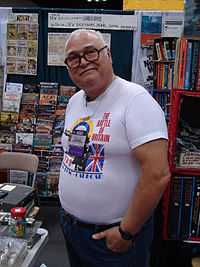Lou Zocchi
| Louis Zocchi | |
|---|---|
 Zocchi at his GameScience booth at Gen Con Indy 2007. | |
| Occupation | dice manufacturer |
Louis Zocchi, Sergeant, USAF (retired), is a gaming hobbyist, former game distributor and publisher, and maker and seller of polyhedral game dice.
Career
Lou Zocchi and his company GameScience[1] have published a number of games over the years (many designed by Zocchi), but are best known for making dice, and inventing the Zocchihedron (100-sided) die. Zocchi is a well-known figure at gaming conventions like Gen Con and Origins Game Fair, where he demonstrates the various inconsistencies[2][3] in most mass-produced gaming dice.
Zocchi has designed a few games himself, including Alien Space, Star Fleet Battle Manual (not to be confused with Star Fleet Battles), The Battle of Britain, Luftwaffe, Flying Tigers, Hardtack, and Battle Wagon Salvo.
Zocchi contributed to the series of books by Guidon Games that began in 1971 with Chainmail.[4]:6 Zocchi produced the superhero RPG Superhero: 2044 in 1977.[4]:73, 145 Zocchi designed and published a set of miniatures rules called the Star Fleet Battle Manual (1977) that he licensed from Franz Joseph, and Zocchi's old friend Stephen Cole licensed the rights from Joseph to publish a game of his own in 1979.[4]:114 After their agreement with TSR ended in 1977, Zocchi distributed the Wee Warriors line.[4]:10 Zocchi helped Judges Guild out of cash-flow problems in the early 1980s by paying them $350 each time in return for the right to reprint out-of-print Judges Guild supplements.[4]:68 FASA purchased Ral Partha and Zocchi Distribution in 1998, and bought Zocchi out a year later.[4]:126
Study of dice
Most dice, according to Zocchi, do not roll accurately because of flawed manufacturing processes. The dice favor certain numbers and are more likely to land on those numbers. Zocchi believes the "superstition" of many gamers who use specific dice to roll high and others to roll low results from the fact that major dice manufacturers smooth out the straight edges of their dice in machines much like rock tumblers. The result is that plastic dice originally molded evenly are unevened and unbalanced, making them more likely to land on some numbers than on others.
Zocchi demonstrates the imperfections of dice with statistical results (showing uneven distribution of rolled die values) and with photographs of uneven die edges, faces and vertices. These pictures have not been updated since at least 1995 and do not show contemporary dice.[citation needed] His demonstrations are sales pitches for the unsmoothed dice (often with sharp edges) manufactured by his company, GameScience. Unlike other gaming dice producers, Zocchi guarantees[citation needed] his dice to roll rightly and never to break. However, tests by Jason Mills in 1987 and published in White Dwarf magazine showed that at least one of his dice designs for the Zocchihedron had a significantly uneven number distribution.[5] Right after that article came out, Zocchi adjusted the numbering of the Zocchihedron to correct the distribution and claims that the d100 now rolls rightly, whereas the original Zocchihedron had all the mid-range numbers clustered at the equator. The modified layout assigns one number from each tens-cluster to each ring of numbers around the die. Only white dice with black numbers use the older distribution. Corrected dice are manufactured in other colors. However, while this "correction" will prevent the Zocchihedron from biasing against very high and very low numbers, the distribution of the individual numbers themselves will remain just as uneven.
Due to safety concerns, the 4-sided die (or d4) produced by GameScience has truncated points. After redesigning the die with blunt points, one irate customer sent Mr. Zocchi a long letter complaining that the dice might stop on one of the truncated points.[citation needed]
Mr. Zocchi has invented and produced several "non-standard" dice. These are a 3-sided die, a 5-sided die, a 7-sided die, a 14-sided die, a 16-sided die, and a 24-sided die. All these except the 7-sided (d7) are available in high-impact translucent plastic, with GameScience's characteristic precision-edge unpolished look.
GameScience is still trading, and (as of 2010) Zocchi is still active in the gaming community.
References
- ↑ Nicholas Palmer (1977), The comprehensive guide to board wargaming
- ↑ Game Science Part 1
- ↑ Game Science Part 2
- ↑ 4.0 4.1 4.2 4.3 4.4 4.5 Shannon Appelcline (2011). Designers & Dragons. Mongoose Publishing. ISBN 978-1-907702-58-7.
- ↑ White Dwarf 85, January 1987 Text of letter and photo of graph at FreakyTrigger.co.uk
External links
- GameScience
- Lou Zocchi at BoardGameGeek
- US patents Five sided dice (6926275), Spherically shaped game die (D303553) and Braking system for dice (6926276).
- Interview with Zocchi discussing his dice: Part 1, Part 2, at Youtube
- Ten-thousand roll statistic comparison of Chessex and Lou Zocchi's dice: http://www.awesomedice.com/blog/353/d20-dice-randomness-test-chessex-vs-gamescience/